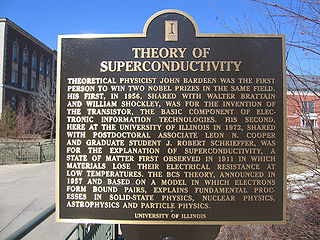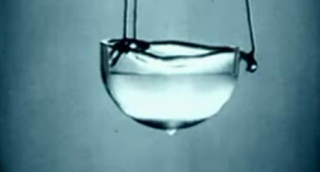Related Research Articles

BCS theory or Bardeen–Cooper–Schrieffer theory is the first microscopic theory of superconductivity since Heike Kamerlingh Onnes's 1911 discovery. The theory describes superconductivity as a microscopic effect caused by a condensation of Cooper pairs. The theory is also used in nuclear physics to describe the pairing interaction between nucleons in an atomic nucleus.

Superconductivity is a set of physical properties observed in certain materials where electrical resistance vanishes and magnetic fields are expelled from the material. Any material exhibiting these properties is a superconductor. Unlike an ordinary metallic conductor, whose resistance decreases gradually as its temperature is lowered, even down to near absolute zero, a superconductor has a characteristic critical temperature below which the resistance drops abruptly to zero. An electric current through a loop of superconducting wire can persist indefinitely with no power source.

Heike Kamerlingh Onnes was a Dutch physicist and Nobel laureate. He exploited the Hampson–Linde cycle to investigate how materials behave when cooled to nearly absolute zero and later to liquefy helium for the first time, in 1908. He also discovered superconductivity in 1911.
Timeline of states of matter and phase transitions

High-temperature superconductors are defined as materials with critical temperature above 77 K, the boiling point of liquid nitrogen. They are only "high-temperature" relative to previously known superconductors, which function at even colder temperatures, close to absolute zero. The "high temperatures" are still far below ambient, and therefore require cooling. The first break through of high-temperature superconductor was discovered in 1986 by IBM researchers Georg Bednorz and K. Alex Müller. Although the critical temperature is around 35.1 K, this new type of superconductor was readily modified by Ching-Wu Chu to make the first high-temperature superconductor with critical temperature 93 K. Bednorz and Müller were awarded the Nobel Prize in Physics in 1987 "for their important break-through in the discovery of superconductivity in ceramic materials". Most high-Tc materials are type-II superconductors.

Willem Hendrik Keesom was a Dutch physicist who, in 1926, invented a method to freeze liquid helium. He also developed the first mathematical description of dipole–dipole interactions in 1921. Thus, dipole–dipole interactions are also known as Keesom interactions. He was previously a student of Heike Kamerlingh Onnes, who had discovered superconductivity.

Johannes Diderik van der Waals was a Dutch theoretical physicist and thermodynamicist famous for his pioneering work on the equation of state for gases and liquids. Van der Waals started his career as a schoolteacher. He became the first physics professor of the University of Amsterdam when in 1877 the old Athenaeum was upgraded to Municipal University. Van der Waals won the 1910 Nobel Prize in physics for his work on the equation of state for gases and liquids.

Liquid helium is a physical state of helium at very low temperatures at standard atmospheric pressures. Liquid helium may show superfluidity.

Paul Ching Wu Chu is a Chinese-American physicist specializing in superconductivity, magnetism, and dielectrics. He is a professor of physics and T.L.L. Temple Chair of Science in the Physics Department at the University of Houston College of Natural Sciences and Mathematics. He was the president of the Hong Kong University of Science and Technology from 2001 to 2009. In 1987, he was one of the first scientists to demonstrate high-temperature superconductivity.
Kamerlingh Onnes is a compound surname of Dutch origin. People with the name include:

Superconductivity is the phenomenon of certain materials exhibiting zero electrical resistance and the expulsion of magnetic fields below a characteristic temperature. The history of superconductivity began with Dutch physicist Heike Kamerlingh Onnes's discovery of superconductivity in mercury in 1911. Since then, many other superconducting materials have been discovered and the theory of superconductivity has been developed. These subjects remain active areas of study in the field of condensed matter physics.

Bernd T. Matthias was a German-born American physicist credited with discoveries of hundreds of elements and alloys with superconducting properties. He was said to have discovered more elements and compounds with superconducting properties than any other scientist.

The Kamerlingh Onnes Award is in recognition of special merits of scientists active in the field of refrigeration technology, cryogenics and more generally low-temperature science and technology. It was founded in 1948 by the Royal Dutch Association of Refrigeration The name of the award is intended to keep the memory of Heike Kamerlingh Onnes alive. The award is assigned typically every four years and the winners get a golden medal and a certificate.
Gilbert "Gil" George Lonzarich is a solid-state physicist who works at the Cavendish Laboratory at the University of Cambridge. He is particularly noted for his work on superconducting and magnetic materials.
J. C. Séamus Davis is an Irish physicist whose research explores the world of macroscopic quantum physics. Davis concentrates upon the fundamental physics of exotic states of electronic, magnetic, atomic and space-time quantum matter. A specialty is development of innovative instrumentation to allow direct atomic-scale visualization or perception of the quantum many-body phenomena that are characteristic of these states.
Aharon Kapitulnik is an Israeli-American experimental condensed matter physicist working at Stanford University. He is known primarily for his work on strongly correlated electron systems, low dimensional electronic systems, unconventional superconductors, topological superconductors, superconductivity and magnetism, transport in bad metals and precision measurements.
Mohit Randeria is a US-based Indian condensed matter physicist and a professor of physics at Ohio State University. Known for his research on condensed matter theory and superconductivity, Randeria is an elected fellow of the American Physics Society. The Council of Scientific and Industrial Research, the apex agency of the Government of India for scientific research, awarded him the Shanti Swarup Bhatnagar Prize for Science and Technology, one of the highest Indian science awards, for his contributions to physical sciences in 2002. He was awarded the 2002 ICTP Prize of the International Center for Theoretical Physics, Trieste and the 2022 John Bardeen Prize.
Nai Phuan Ong is an American experimental physicist, specializing in "condensed matter physics focusing on topological insulators, Dirac/Weyl semimetals, superconductors and quantum spin liquids."
Pengcheng Dai is a Chinese American experimental physicist and academic. He is the Sam and Helen Worden Professor of Physics in the Department of Physics and Astronomy at Rice University.
In physics, the Matthias rules refers to a historical set of empirical guidelines on how to find superconductors. These rules were authored Bernd T. Matthias who discovered hundreds of superconductors using these principles in the 1950s and 1960s. Deviations from these rules have been found since the end of the 1970s with the discovery of unconventional superconductors.
References
- ↑ "Home". Heike Kamerlingh Onnes Prize.
- ↑ Chu, P.C. (2000). "International Conference on Materials and Mechanisms of Superconductivity and High Temperature Superconductors (6th) Held in Houston, Texas on February 20-25, 2000, hosted by the Texas Center for Superconductivity Houston". Defense Technical Information Center.
- ↑ Boyd, Jade (January 14, 2022). "Rice physicist Pengcheng Dai wins superconductivity award". News and Media Relations, Office of Public Affairs, Rice University.
- ↑ "Past Kamerlingh Ommes Prize Recipients".